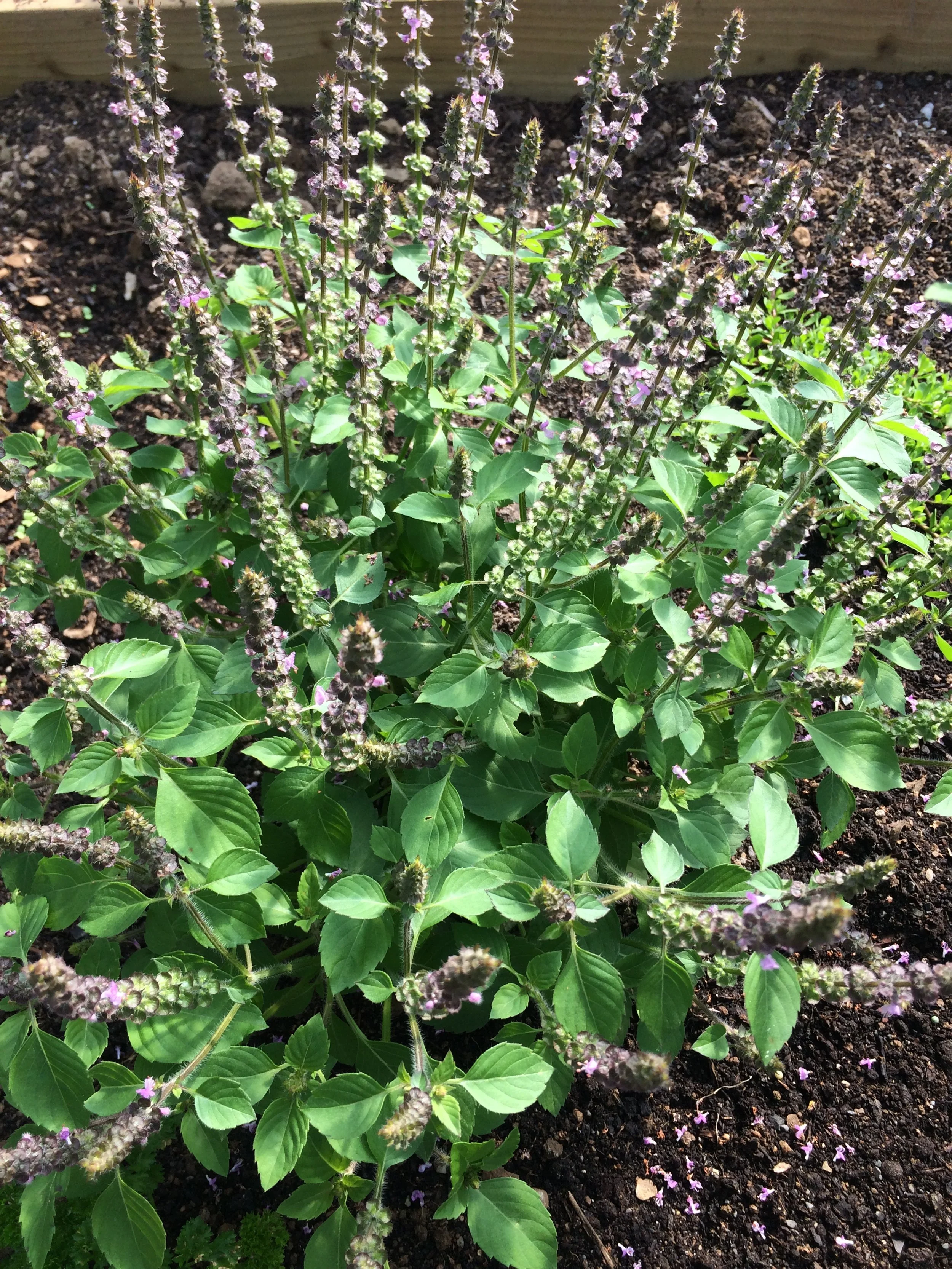
Ocimum tenuiflorum
Tulsi, Holy basil
Botany
O. tenuiflorum holds significant ethnomedicinal value and belongs to the Lamiaceae (Mint) family. In Ayurveda, the aromatic medicinal plant is often referred to as the “elixir of life”. It is primarily native to tropical and subtropical regions. In 1753, Linnaeus described five species of the Ocimum genus. Today, over 50 species are recognized for their possible medicinal use.. Ocimum tenuiflorum, also called Tulsi in Nepali and Hindi and Holy Basil in English, is one of the most important species..
O. tenuiflorum is an herbaceous plant that can be either annual or perennial, depending on the specific variety and the growing conditions. It is a branched shrub-like plant that can grow up to approximately 1 meter tall. This plant is highly aromatic and features some woody tissue at the base of its stems, providing structural support. The leaves are broadly elliptical in shape and have a pubescent, or softly hairy, surface texture. They typically measure between 3 to 6 centimeters in length and 1 to 2.5 centimeters in width. Its flowers, which are a delicate purple-pink color, appear at the terminal ends of the branches and form slender racemes or panicles. The stems are four-angled and covered with fine hairs.
O. tenuiflorum, particularly the Kapoor variety, grows well in Europe as an annual herb and can be successfully cultivated with little care throughout the warm season. You can buy some seeds in Laura’s Shop.
Parts Used
The entire plant can be used medicinally, but the leaves and flowers are most commonly used in traditional herbalism. It is a highly aromatic plant, known for its rich and fragrant scent. The flavour resembles clove, accompanied by subtle spicy and sweet hints that enhance its overall complexity.. O. tenuiflorum has long been used not only for its medicinal benefits but also to add a distinctive and pleasant flavor to various foods and beverages.
Phytochemistry
O. tenuiflorum is richly loaded with a variety of phytochemicals, which are responsible for its diverse therapeutic actions and health benefits.. It contains a variety of essential oils, including monoterpene compounds such as a-pinene, limonene, estragol and eugenol. It is also rich in flavonoids like luteolin, quercetin, apigenin, vitexin, among others. In addition, this herb features several phenols and phenolic acids, with rosmarinic acid, chlorogenic acid, caffeic acid, vanillin, and ferulic acid being prominent examples. Furthermore, it includes multiple triterpenoids and steroids, such as β-sitosterol and ursolic acid, which contribute to its diverse properties.
Actions
The properties of O tenuiflorum are antioxidant, antimicrobial, antifungal, antidiabetic, anti-stress, and anti-inflammatory. Additional beneficial actions include cardioprotective, hepatoprotective, neuroprotective, anticancer, analgesic, antiemetic, antipyretic, anticholinergic, vulnerary, radiation protective, and immunomodulatory effects. It is widely regarded as both a nervine tonic and an adaptogen, supporting overall nervous system health and helping the body adapt to various stressors.
Traditional Uses
O. tenuiflorum has a long history of traditional use for coughs, common colds, respiratory disorders, arthritis, gout, persistent fever, digestive issues, hemorrhoids, abdominal pains, urinary tract infection, diabetes, eye and ear complaints, headaches, malaise, soreness, fever, swelling.
Scientific Research
O. tenuiflorum is a source of antioxidants itself and its metabolites can interact with various pathways by stimulating, inhibiting, upregulating, or downregulating numerous body molecules. This action helps enhance the body's antioxidant capacity.
Antimicrobial - O. tenuiflorum has been shown to inhibit Gram-positive and Gram-negative bacteria. Eugenol e.g. can penetrate bacterial cell walls, particularly in Gram-negative bacteria, that lead to the leakage of intracellular components and bacterial cell death. Additionally, eugenol inhibits crucial bacterial enzymes, such as proteases and membrane-bound ATPases, disrupting essential metabolic processes. Furthermore, it induces oxidative stress by generating ROS, which damage cellular components, including DNA, proteins, and lipids.
Antifungal activity of O. tenuiflorum essential oil was demonstrated against Candida albicans.
Antidiabetic - O. tenuiflorum metabolites are known to reduce blood glucose and inhibit the α-glucosidase enzyme, which is a key enzyme for catalyzing carbohydrate digestion. Sethi et al. studied the antidiabetic activity of leaves of O. tenuiflorum and reported that chewing the leaves 2-g/kg body weight for the subsequent 30 days led to lower blood glucose levels in the tested group
Anti-inflammatory - some phytochemicals O. tenuiflorum are potent anti-inflammatories that work by inhibiting pro-inflammatory cytokines and help reduce inflammation.
Anti-stress - For relief from stress, O. tenuiflorum is considered one of the best medicinal plants. It demonstrated cortisol reducing and weight increasing, resistance enhancing effects in animal studies.
Sethi et al. observed that a doze of 2 g of O. tenuiflorum leaves for 30 days resulted in a notable decline in the sperm count, a reduction in follicle-stimulating hormone, and a rise in serum testosterone levels
Safety
O. tenuiflorum is a nontoxic herb and is generally safe for use by most individuals. O. tenuiflorum possesses some phytochemicals that exhibit antifertility action, which should be carefully considered if you are trying to conceive.
Resources
https://pmc.ncbi.nlm.nih.gov/articles/PMC11521583/
Back to Herbs
